Female Cryptotympana atrata photo by Jon Allen from 2006. Taken in South Korea.
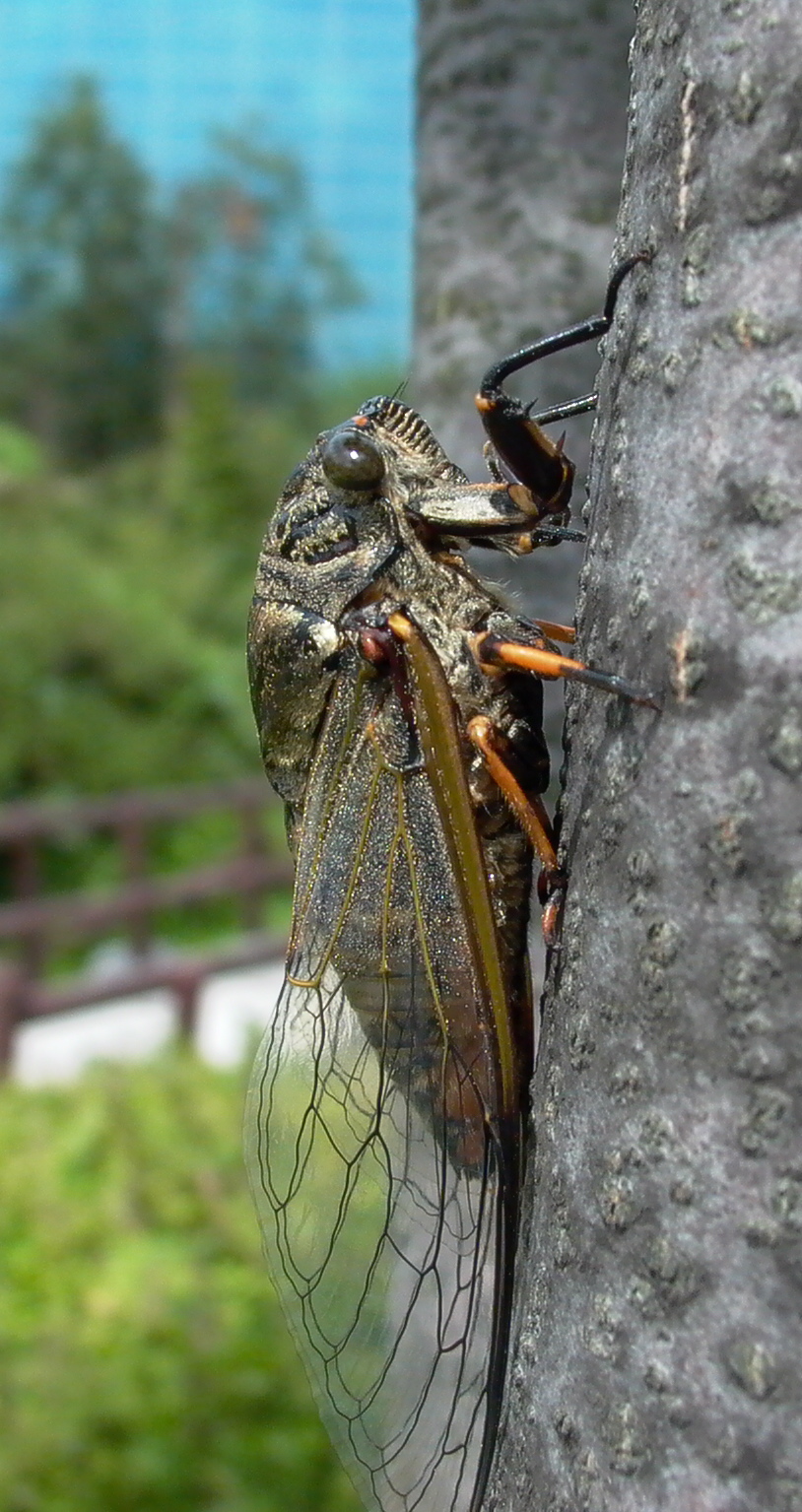
Dedicated to cicadas, the most amazing insects in the world.
Female Cryptotympana atrata photo by Jon Allen from 2006. Taken in South Korea.


Can you identify this cicada from Kota Kinabalu, Malaysia? The photo was taken by photographer Karim Madoya.
Update: here’s what it is: Cryptotympana aquila.
Scientific classification:
Family: Cicadidae
Subfamily: Cicadinae
Tribe: Cryptotympanini
SubTribe: Cryptotympanina
Genus: Cryptotympana
Species: Cryptotympana aquila (Walker, 1850)
Cryptotympana mandarina is a cicada found in China, Laos, Vietnam, India, Thailand, and likely adjacent nations.
Photo by Michel Chantraine:
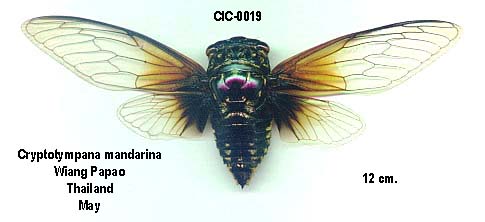
This description comes from A Monograph of Oriental Cicadas by W. L. Distant. 1889-1892. Read it on the Biodiversity Heritage Library website:
Male: Body above black; eyes fuscous; the anal segment of the abdomen with an ochraceous spot on each side. Body beneath and legs black; a spot at the anterior margin of the face, two marginal spots between face and eyes, lateral margins of face, femoral streaks, posterior tibiae (excluding bases and apices), margins of opercula, segmental margins (excluding disk), and apex of terminal segment, dark ochraceous.
Tegmina and wings hyaline, the venation fuscous; tegmina with the costal membrane castaneous, its extreme costal edge blackish, the post-costal area blackish; basal cell black; about the basal third of tegmina and the subcostal area to ax^es pale castaneous. Wings with about basal half irregularly very dark castaneous.
The opercula extend to about half the length of the abdomen, slightly overlap at the basal margin, somewhat concavely and obliquely sinuate at outer margins, and inwardly beyond base widely divergent to apices, which are narrowly and obtusely convex.
Long. excl. tegm. Male. 40 millim. Exp. tegm. 115 millim.
Scientific classification:
Family: Cicadidae
Subfamily: Cicadinae
Tribe: Cryptotympanini
SubTribe: Cryptotympanina
Genus: Cryptotympana
Species: Cryptotympana mandarina Distant, 1891
Cryptotympana aquila is a cicada found in Indonesia, Malaysia, Brunei, Thailand, and likely adjacent nations.
Photo by Michel Chantraine:
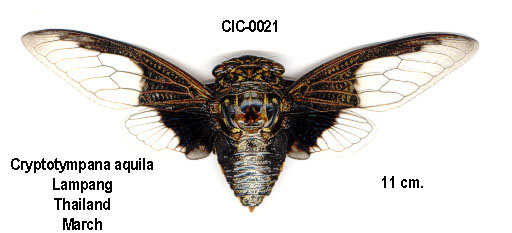
This description comes from A Monograph of Oriental Cicadas by W. L. Distant. 1889-1892. Read it on the Biodiversity Heritage Library website.
Male: Body above black; eyes ochraceous; ocelli luteous. Pronotum with some indistinct discal markings and the posterior margin pale castaneous. Mesonotum with a central triangular linear fascia, on each side of which is an irregular and inwardly notched fascia, and the basal cruciform elevation, pale castaneous. Abdomen black, the lateral margins fringed with pale castaneous pile. Body beneath very pale castaneous; the face, anterior margin of the head between face and eyes, and basal abdominal patch, black. Anterior legs black, the femera streaked with pale castaneous; intermediate legs with the femora black streaked with pale castaneous, the tibis pale castaneous with their bases and apices black; posterior legs pale castaneous, the bases and apices of femora and tibiae black.
Tegmina and wing pale hyaline; tegmina with the venation and the costal membrane pale castaneous, the extreme basal margin of the last black; the basal third (excluding venation) and the subcostal area to apex, blackish; wings with about basal half obliquely black.
The body is robust but moderately elongate; the opercula do not overlap at their basal margins, and at a short distance from base become widely divergent and narrowed to apices, their outer margins slightly concavely sinuate and in length, they extend a little beyond the middle of the abdomen.
Long. excl. tegm. Male, 40 to 45 millim. Exp. tegm. 115 to 120 millim.
Scientific classification:
Family: Cicadidae
Subfamily: Cicadinae
Tribe: Cryptotympanini
SubTribe: Cryptotympanina
Genus: Cryptotympana
Species: Cryptotympana aquila (Walker, 1850)
Cryptotympana atrata (Fabricius, 1775) is a cicada found in China and Korea.
Scientific classification:
Family: Cicadidae
Subfamily: Cicadinae
Tribe: Cryptotympanini
SubTribe: Cryptotympanina
Genus: Cryptotympana
Species: Cryptotympana atrata (Fabricius, 1775)
Cryptotympana atrata was formerly named Cryptotympana sinensis.
.
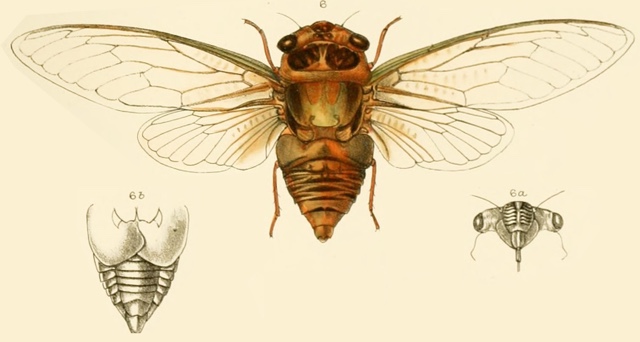

Photo by Jon Allen in Yeouido park in Seoul in South Korea.
(Cryptotympana sinensis) species description from A Monograph of Oriental Cicadas by W.L. Distant:
[Male] Head ochraceous; front with the margins (but not meeting at apex) broadly castaneous; eyes olivaceous; ocelli reddish-ochraceous, with their surrounding area castaneous. Pronotum castaneous, the margins and a central fascia, which is much widened and ampliated at base, ochraceous. Mesonotum ochraceous, with two large obconical castaneous spots near each lateral margin and two large, central, very obscure obconical spots, which are only visible by their slightly darker margins; basal cruciform elevation pale olivaceous. Abdomen above ochraceous, the posterior segmental margins castaneous. Body beneath and legs ochraceous; face with the lateral carinae castaneous; apices of the tibiae and tarsi castaneous.
Tegmina pale hyaline, the venation ochraceous, the costal membrane pale greenish, and the basal third of the tegminal area tinged with pale ochraceous. Wings pale hyaline, the venation ochraceous, and the base narrowly tinged with pale ochraceous.
The face is tumid, the lateral carina robust and slightly waved; the rostrum extends to the intermediate coxae; the opercula are somewhat short, with their lateral margins slightly concave and their posterior margins oblique, they overlap at the center, and their apices extend to about the second abdominal segment.
Long. excl. tegm. [male] 40 millim. Exp. tegm. 118 millim.
There are two subspecies of Cryptotympana holsti: Cryptotympana holsti holsti Distant, 1904 and Cryptotympana holsti takahashii Kato, 1925. Cryptotympana holsti is found in Taiwan, China, Vietnam, Cambodia, Laos, and perhaps elsewhere in southwestern Asia.
Scientific classification:
Family: Cicadidae
Subfamily: Cicadinae
Tribe: Cryptotympanini
SubTribe: Cryptotympanina
Genus: Cryptotympana
Species: Cryptotympana holsti
Subspecies: Cryptotympana holsti holsti Distant, 1904
Subspecies: Cryptotympana holsti takahashii Kato, 1925
Not sure which subspecies this is, but I’m guessing Cryptotympana holsti holsti Distant, 1904: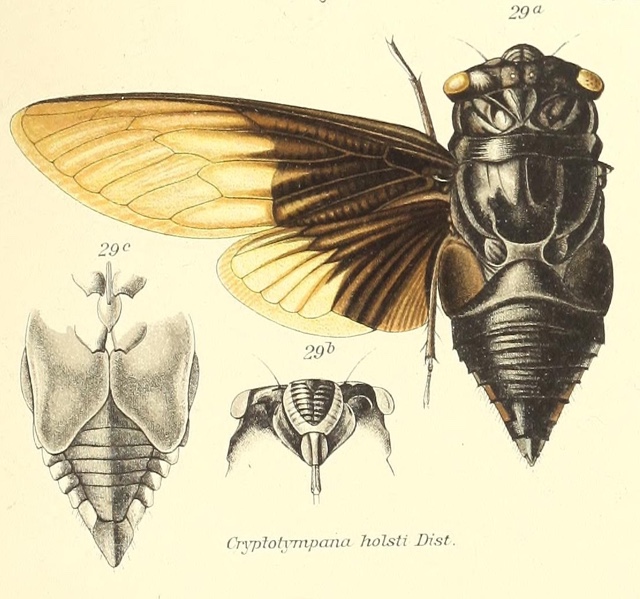
Cryptotympana genus description by W. L. Distant:
Characters. — Head broad, more or less transversely truncate between the eyes, including which it is a little broader than the base of mesonotum, its length only slightly more than half the breadth between eyes, ocelli about twice the distance from eyes as from each other, front slightly prominent; pronotum about as long as mesonotum, its lateral margins oblique, the posterior angles a little ampliate; abdomen in male about as long as space between apex of head and base of cruciform elevation, the tympanal orifices concealed by the tympanal coverings; opercula in male well developed, varying in shape and size; metasternum elevated at middle and furnished with a posterior process directed backward; anterior femora strongly spined beneath; tegmina hyaline or semi-opaque, basal cell longer than broad; apical areas eight.
The NCSU Libraries Rare and Unique Digital Collections website recently reminded the us of artist Eugene Alain (E.A.) Seguy’s insect illustrations. Seguy created these illustrations in the 1920’s, and as you might imagine, some of the cicada names cited in the notes for these illustrations have changed. Names typically change when cicadas are reclassified due to discoveries about their biology, or when we realize that someone else had actually named them earlier than the namer currently given credit.
Here are the two illustrations, the accompanying identification, and corrected identifications.
Illustration:
Accompanying identification:
1. Tacua speciosa. Indes; 2. Polyneura ducalis. Indes Or.; 3. Cicada saccata. Australie; 4. Cicada fascialis. Siam; 5. Tozena melanoptera. Indes Or.
Corrected or expanded identification:
Illustration:
Accompanying identification:
1. Goeana festiva. Indes; 2. Zammara tympanum. Amérique du Sud; 3. Goeana ochracea. Indes; 4. Phenax variegata. Brésil; 5. Hemisciera maculipennis. Amazone
Corrected or expanded identification:
The photo below was taken by Jon Allen in Yeouido park in Seoul in South Korea. Click the image for a huge version. Anyone know what it is?